Best of Success 2006
The third annual Roofing Contractor Best of Success Conference was bigger and better than ever. Attendance figures for the event have risen every year, and at this year’s event more than 200 elite contractors joined manufacturer sponsors and industry executives for the two-day educational conference. The meeting room at Pointe South Mountain Resort in Phoenix was filled to capacity as contractors eager to improve their business practices and bolster their bottom lines participated in educational seminars and panel discussions led by industry experts, including top-flight commercial and residential roofing contractors.
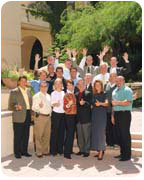
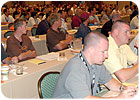 The third annual Roofing Contractor Best of Success Conference was bigger and better than ever. Attendance figures for the event have risen every year, and at this year’s event more than 200 elite contractors joined manufacturer sponsors and industry executives for the two-day educational conference. The meeting room at Pointe South Mountain Resort in Phoenix was filled to capacity as contractors eager to improve their business practices and bolster their bottom lines participated in educational seminars and panel discussions led by industry experts, including top-flight commercial and residential roofing contractors.
The third annual Roofing Contractor Best of Success Conference was bigger and better than ever. Attendance figures for the event have risen every year, and at this year’s event more than 200 elite contractors joined manufacturer sponsors and industry executives for the two-day educational conference. The meeting room at Pointe South Mountain Resort in Phoenix was filled to capacity as contractors eager to improve their business practices and bolster their bottom lines participated in educational seminars and panel discussions led by industry experts, including top-flight commercial and residential roofing contractors.
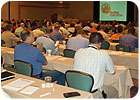 The energetic series of educational sessions was complemented by ample opportunities for peer networking. Roundtable luncheons featured opportunities to talk one-on-one with event speakers, and an evening cocktail reception held by firelight on the Palms Court after the first day of seminars kept the conversation going well into the evening.
The energetic series of educational sessions was complemented by ample opportunities for peer networking. Roundtable luncheons featured opportunities to talk one-on-one with event speakers, and an evening cocktail reception held by firelight on the Palms Court after the first day of seminars kept the conversation going well into the evening.
Roofing Contractor’s publisher, Jill Nash, kicked off the event by welcoming the speakers and attendees and holding the first of 11 random drawings. Eleven lucky contractors received Hemi hammer drills, and all of those who attended the event received a coupon booklet featuring offers from the event’s manufacturer sponsors with a retail value in excess of $3,200.
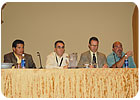
He provided an overview of the industry today, using the September issue of Roofing Contractor magazine as a springboard. “First thing I noticed was the ads for steep-slope roofing products,” he stated. “Lots of them, thankfully, but most touting a unique system, not just page after page of ‘me, too.’ The variety of products offered in the steep-slope market today is dramatic, and, I believe, points to a world of opportunities to roofing contractors willing to invest in them.”
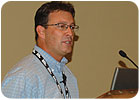 He then pointed to the number of ads from roofing suppliers. “The world of roofing distribution continues to evolve, and the consolidation of roofing distribution will continue and probably increase over the next few years. You will see consolidation in other building products divisions as large retailers like Home Depot move to acquire firms supplying building professionals - a departure from their retail or do-it-yourselfer orientation. They realize that as the baby boomer population grows older, they will move away from ‘do-it-yourself’ to ‘do-it-for-me,’ a fact that is not particularly bad news for contractors. In fact, you who do business in the residential retrofit market will be smart to focus on this demographic as they find the time and have the money to improve their primary and even second homes.”
He then pointed to the number of ads from roofing suppliers. “The world of roofing distribution continues to evolve, and the consolidation of roofing distribution will continue and probably increase over the next few years. You will see consolidation in other building products divisions as large retailers like Home Depot move to acquire firms supplying building professionals - a departure from their retail or do-it-yourselfer orientation. They realize that as the baby boomer population grows older, they will move away from ‘do-it-yourself’ to ‘do-it-for-me,’ a fact that is not particularly bad news for contractors. In fact, you who do business in the residential retrofit market will be smart to focus on this demographic as they find the time and have the money to improve their primary and even second homes.”
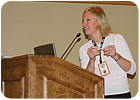 While on the subject of suppliers, Damato had another observation for contractors. “Firms who supply professional contractors are very typically ruled by Pareto’s Law. That is, 80 percent of their business comes from 20 percent of their customer list. I think as consolidation grows and technology impacts buying patterns, this could move toward 90/10. Call that Damato’s Law. As a contractor, you should realize that as suppliers grow more sophisticated, they will do a better and better job of managing their customer relations, and your position in the equation (Pareto’s or Damato’s or someone else’s) will ultimately have an impact on the level of pricing and service you receive. My advice to contractors is to be proactive and take a stand in managing that relationship. Be important to your primary supplier or suppliers, do your part in each transaction, and demand the kind of service and support that you need to compete. It does matter to both of you. They sell nothing until you land a job.”
While on the subject of suppliers, Damato had another observation for contractors. “Firms who supply professional contractors are very typically ruled by Pareto’s Law. That is, 80 percent of their business comes from 20 percent of their customer list. I think as consolidation grows and technology impacts buying patterns, this could move toward 90/10. Call that Damato’s Law. As a contractor, you should realize that as suppliers grow more sophisticated, they will do a better and better job of managing their customer relations, and your position in the equation (Pareto’s or Damato’s or someone else’s) will ultimately have an impact on the level of pricing and service you receive. My advice to contractors is to be proactive and take a stand in managing that relationship. Be important to your primary supplier or suppliers, do your part in each transaction, and demand the kind of service and support that you need to compete. It does matter to both of you. They sell nothing until you land a job.”
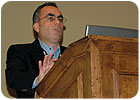 He touched on other key issues at the heart of the industry, including the increasing emphasis on “cool” and “sustainable” roofing systems. “This trend is being driven by the combination of demand from building owners and the investment of more and more firms in the technologies and products required to meet that demand,” he said. “We are now one of the darlings of the building industry. Our highly reflective and well-insulated membrane roofing systems are finally being given the respect they have always deserved. Now the design community is on our side promoting truly better roofing systems and practices. This is a fantastic opportunity, and you in the commercial roof contracting business really should ramp up your sales and marketing to set yourself up as the roofing contractor in your market to provide energy-saving, sustainable roofing systems.”
He touched on other key issues at the heart of the industry, including the increasing emphasis on “cool” and “sustainable” roofing systems. “This trend is being driven by the combination of demand from building owners and the investment of more and more firms in the technologies and products required to meet that demand,” he said. “We are now one of the darlings of the building industry. Our highly reflective and well-insulated membrane roofing systems are finally being given the respect they have always deserved. Now the design community is on our side promoting truly better roofing systems and practices. This is a fantastic opportunity, and you in the commercial roof contracting business really should ramp up your sales and marketing to set yourself up as the roofing contractor in your market to provide energy-saving, sustainable roofing systems.”
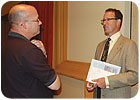
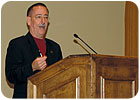 Harrison highlighted the most recent survey statistics, in which contractors cited that 40 percent of their reroofing jobs were done in conjunction with consultants, as proof of the importance of solid working relationships between members of the two professions. The survey indicated that mutual respect between the two groups has been growing, stated Harrison, but he noted the survey also made clear there were still problem areas that could be seen as business opportunities for contractors.
Harrison highlighted the most recent survey statistics, in which contractors cited that 40 percent of their reroofing jobs were done in conjunction with consultants, as proof of the importance of solid working relationships between members of the two professions. The survey indicated that mutual respect between the two groups has been growing, stated Harrison, but he noted the survey also made clear there were still problem areas that could be seen as business opportunities for contractors.
Pointing to survey results in which contractors and consultants gave each other low scores in the areas of timeliness, communication and the handling of change orders, Harrison turned the tables on his expert panelists when he asked them this question: “If you suddenly found yourself in charge of the other type of business, what would you do differently?”
Madsen focused on the importance of clear lines of communication. “Things aren’t built in a laboratory, they’re built under real-world conditions, and unplanned events come up,” he said. “The owner has a right to know about the project, but communication between the contractor and the consultant is essential.”
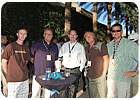 Gaulin concurred that communication was key, and he stressed the importance of pre-project meetings. “I’ve worked with some strict consultants who want exactly what they specify - no more, no less. If that’s the case, you have to know that up front. The real intent is to understand the scope of the work, the desired goal, and approach the work that way.”
Gaulin concurred that communication was key, and he stressed the importance of pre-project meetings. “I’ve worked with some strict consultants who want exactly what they specify - no more, no less. If that’s the case, you have to know that up front. The real intent is to understand the scope of the work, the desired goal, and approach the work that way.”
Hutchinson cited the punch list as a common point of contention on roof projects. “Sometimes it seems the last 10 percent of the project takes 90 percent of the time,” he said. “My advice is to make sure the punch list items are done before you leave the roof. Initial the punch list and document the work with photos to ensure that you have proof of completion.”
D’Annunzio pointed out that many contractors have a separate crew that specializes in completing projects. “If you have a crew set up just to do punch list items such as sealant touch-up, it helps projects flow smoothly and eliminates payment problems,” he noted. A separate maintenance department is another great idea for contractors, advised D’Annunzio, as manufacturers’ warranties stipulate that building owners are responsible for proper maintenance. “Your own maintenance department can make a customer a customer for life.”
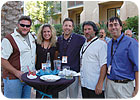 Bids are another facet of the job fraught with pitfalls, according to Hutchinson. “I’ve seen bids without the company name and contact information,” he said. “Impressive bids list all of the contact information for the foreman and the president, as well as emergency contact numbers.”
Bids are another facet of the job fraught with pitfalls, according to Hutchinson. “I’ve seen bids without the company name and contact information,” he said. “Impressive bids list all of the contact information for the foreman and the president, as well as emergency contact numbers.”
D’Annunzio pointed to the bidding process as a way for contractors to differentiate themselves from the competition by pointing out that they offer services that others may not and detailing how change orders and punch lists should be handled. The specific details of the bid are the most crucial element, according to D’Annunzio, and contractors ignore them at their peril. “You must bid the spec,” he asserted. “If you include another product, you won’t get the job. If you think another product is advisable, include it as a voluntary alternate.”
Harrison concurred, urging attendees to go above and beyond what was expected at every phase of the process. “Answer what was asked, but add explanations of what goes beyond the minimum proposal,” advised Harrison. “Separate yourself from the competition. Don’t become a commodity.”
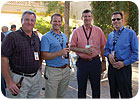
Fryer extolled the benefits of the NRCA’s crisis management guidelines, which are spelled out in its publication titled “Crisis Management: The Time Is Now.” Key concerns identified by Fryer include taking all steps to prevent accidents before they occur by identifying potential hazards at every jobsite, including fire, explosions, falls, burns, electrocution, vehicle accidents, property/water damage, and injuries to pedestrians or building occupants. Other musts include establishing a crisis management team with clearly defined roles, including naming a company spokesperson and ensuring that all employees know who to direct requests to when the family or the media contacts them for information. “You have to plan and prepare, but you never really know how you or your people are going to react in a crisis,” said Fryer, whose company had only experienced one other accident in 25 years.
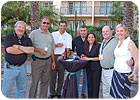 After the accident, the company ruled out the use of torch-applied systems over combustible decks, mandated CERTA training for all torch users, and renewed its emphasis on reviewing all Material Safety Data Sheets and conducting a thorough jobsite safety analysis on every project.
After the accident, the company ruled out the use of torch-applied systems over combustible decks, mandated CERTA training for all torch users, and renewed its emphasis on reviewing all Material Safety Data Sheets and conducting a thorough jobsite safety analysis on every project.
Baxter used his own firm’s experience coping with tragedy as a wake-up call for fellow contractors without a crisis management program in place. The accidental death of a supervisor who fell off a commercial roof before the safety manager had arrived on site shocked Baxter’s company in 2005. The investigation into the accident was further complicated by the lack of a Spanish translator on the site. Baxter also found it difficult to reach the family to give them the news because the contact information in the employee’s file was not up to date.
 The company now updates and checks contact information for every employee every six months. Other recommendations from Baxter include conducting a thorough investigation of the incident, with a translator on hand if needed, as well as recording all interviews on videotape. “Keep meticulous records and all documentation,” advised Baxter. “Be responsive to authorities, but do not rush to provide all documentation. If necessary, request time extensions to ensure that all documentation can be gathered and copied, and keep copies of all documents sent out, such as OSHA requests.”
The company now updates and checks contact information for every employee every six months. Other recommendations from Baxter include conducting a thorough investigation of the incident, with a translator on hand if needed, as well as recording all interviews on videotape. “Keep meticulous records and all documentation,” advised Baxter. “Be responsive to authorities, but do not rush to provide all documentation. If necessary, request time extensions to ensure that all documentation can be gathered and copied, and keep copies of all documents sent out, such as OSHA requests.”
Baxter seconded Fryer’s emphasis on jobsite safety analyses, as well as safety audits and equipment and vehicle inspections. “We revamped the CRS safety program to go above and beyond OSHA regulations,” said Baxter. “Make safety a company culture.”
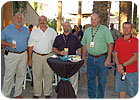
Gaulin pointed out that the association added 598 new members in the past year - it’s best growth year ever - and instituted several new benefits for members, including discount programs with Shell Oil, Firestone retail stores, American Express and LaborChex. “The 3 percent Shell Oil discount alone should pay back your dues in one year,” he said.
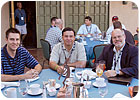 Other goals included expanding the association’s international presence and becoming an even more vital force in Washington, where the association continues to push for responsible immigration reform and changes in insurance legislation. Gaulin also touted new publications including the Architectural Sheet Metal and Metal Roofing Manual, Spray Polyurethane Foam-Based Manual and Low–Slope Roofing Materials Guide, as well as the NRCA Manual on CD.
Other goals included expanding the association’s international presence and becoming an even more vital force in Washington, where the association continues to push for responsible immigration reform and changes in insurance legislation. Gaulin also touted new publications including the Architectural Sheet Metal and Metal Roofing Manual, Spray Polyurethane Foam-Based Manual and Low–Slope Roofing Materials Guide, as well as the NRCA Manual on CD.
Gaulin spelled out several ongoing goals for the association in the year ahead, including taking the lead in energy and environmental issues, improving relations with affiliates and manufacturers, and engaging in regulatory issues, including actively participating in the asphalt fume coalition and developing an online engineering tool to replace the guidelines in FM 1-29.
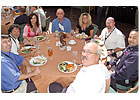
“I think attending the conference is just as important as a good insurance plan, well-maintained vehicles or the right marketing plan - it’s a must,” stated Mark Franzoso, president of Franzoso Contracting Inc., Croton-on-Hudson, N.Y., who was attending the conference for the second time. “The presentations from fellow contractors had a big impact. We are actually working on putting together a crisis management team, which we’ve never had before.”
“You need to go to this conference and use it as a tool to improve your business and to get a jump-start for next year,” said Joel Long, vice president of Gastonia Sheet Metal Works Inc., Gastonia, N.C. “It’s done that for us each of the three years we went.”
William Johns, president of Summit Roofing Inc., Missoula, Mont., said, “One of the biggest assets of the Best of Success Conference is getting the chance to interact and network with other contractors who are outside of your area and are not necessarily direct competitors. We were able to question other successful contractors on the logistics of personnel and how I would apply their methods in expanding my business.”
 “I’ve attended roofing industry conferences for 30 years, and the rapid pace of the Best of Success series makes it one of my favorites,” stated Rick Damato. “The conference sessions are packed with great information you can take home and put to work right away, and the chance to interface with some of the roofing industry’s top players always provides a learning experience that can only be described as truly unique.”
“I’ve attended roofing industry conferences for 30 years, and the rapid pace of the Best of Success series makes it one of my favorites,” stated Rick Damato. “The conference sessions are packed with great information you can take home and put to work right away, and the chance to interface with some of the roofing industry’s top players always provides a learning experience that can only be described as truly unique.”
“It’s been exciting for us to watch Best of Success grow into what it is today,” said Jill Nash. “The Best of Success Conference would not be possible without the help of our sponsors, and I’d like to thank ABC Supply Co., Allied Building Products, Bradco Supply, CARE, CertainTeed, Elk Premium Building Products, GAF Materials Corp., Hemi Power Tools, IKO, Johns Manville, Lapolla Coatings, OMG Roofing Products, Owens Corning, Polyglass, SFS Intec, and TAMKO Building Products.”
Nash indicated that the dates were already set for next year’s event, which will again be held at Pointe South Mountain Resort in Phoenix Sept. 19-20. Look for more information on Best of Success 2007 in future issues of Roofing Contractor.



Roofing Contractor’s publisher, Jill Nash, kicked off the event by welcoming the speakers and attendees and holding the first of 11 random drawings. Eleven lucky contractors received Hemi hammer drills, and all of those who attended the event received a coupon booklet featuring offers from the event’s manufacturer sponsors with a retail value in excess of $3,200.

Contractors vs. Consultants panelists (from left) Christian Madsen, Mark Gaulin, Tom Hutchinson and John D’Annunzio discuss change orders.
State of the Industry
Rick Damato, operations director of JGA in Atlanta and Roofing Contractor’s editorial director, opened the conference with an introductory session titled “The State of the Industry.” After thanking the event’s sponsors, Damato cautioned that his opinions should be taken with a grain of salt. “Don’t assume anything about my level of expertise just because they let me write in the magazine or address this conference,” he said.He provided an overview of the industry today, using the September issue of Roofing Contractor magazine as a springboard. “First thing I noticed was the ads for steep-slope roofing products,” he stated. “Lots of them, thankfully, but most touting a unique system, not just page after page of ‘me, too.’ The variety of products offered in the steep-slope market today is dramatic, and, I believe, points to a world of opportunities to roofing contractors willing to invest in them.”

Bruce Fryer spearheads the session on crisis management.

Roofing Contractor Publisher Jill Nash reads the name of the winner during one of the drawings for a Hemi drill. Eleven drills were awarded in all.

Mark Gaulin updates attendees on the state of the NRCA.

Tom Hutchinson answers a question after the panel discussion on contractors and consultants.
Contractors and Consultants
The panel discussion titled “Contractors vs. Consultants” was inspired by Roofing Contactor’s surveys on the attitudes of contractors about consultants - and vice versa. Moderated by Dave Harrison of GAF Materials Corp. and the Center for the Advancement of Roofing Excellence (CARE), the session was designed to help contractors and consultants understand each others’ needs and desires when it comes to issues such as roof design, change orders and quality control. Panelists include Mark Gaulin, current president of NRCA and president of Magco Inc., a Tecta America company, Jessup, Md.; Christian Madsen, vice president of Madsen Roof Co. Inc., Sacramento, Calif.; John D’Annunzio of IRT Inc., with offices in Shelby Township, Mich., and Fort Lauderdale, Fla.; and Tom Hutchinson, a principal in Hutchinson Design Group, Ltd., and immediate past president of RCI Inc., the Institute of Roofing, Waterproofing and Building Envelope Professionals.
Rick Damato opened the conference by examining trends in the roofing industry.
Pointing to survey results in which contractors and consultants gave each other low scores in the areas of timeliness, communication and the handling of change orders, Harrison turned the tables on his expert panelists when he asked them this question: “If you suddenly found yourself in charge of the other type of business, what would you do differently?”
Madsen focused on the importance of clear lines of communication. “Things aren’t built in a laboratory, they’re built under real-world conditions, and unplanned events come up,” he said. “The owner has a right to know about the project, but communication between the contractor and the consultant is essential.”

Celebrating another successful Best of Success Conference are (from left) Martin Saeger of Great American Roofing Co., Mike Cellura of CertainTeed, Ricardo González of Bilingual America, and Matt Saeger and Rod Menzel of Great American Roofing Co.
Hutchinson cited the punch list as a common point of contention on roof projects. “Sometimes it seems the last 10 percent of the project takes 90 percent of the time,” he said. “My advice is to make sure the punch list items are done before you leave the roof. Initial the punch list and document the work with photos to ensure that you have proof of completion.”
D’Annunzio pointed out that many contractors have a separate crew that specializes in completing projects. “If you have a crew set up just to do punch list items such as sealant touch-up, it helps projects flow smoothly and eliminates payment problems,” he noted. A separate maintenance department is another great idea for contractors, advised D’Annunzio, as manufacturers’ warranties stipulate that building owners are responsible for proper maintenance. “Your own maintenance department can make a customer a customer for life.”

Enjoying the atmosphere at the Palms Court are (from left) Ray Byrne of American Roofing, Katie Armbrust of HJE Marketing, and Dan Williams, John Simonelli and Keith Rozolis of ABC Supply Co.
D’Annunzio pointed to the bidding process as a way for contractors to differentiate themselves from the competition by pointing out that they offer services that others may not and detailing how change orders and punch lists should be handled. The specific details of the bid are the most crucial element, according to D’Annunzio, and contractors ignore them at their peril. “You must bid the spec,” he asserted. “If you include another product, you won’t get the job. If you think another product is advisable, include it as a voluntary alternate.”
Harrison concurred, urging attendees to go above and beyond what was expected at every phase of the process. “Answer what was asked, but add explanations of what goes beyond the minimum proposal,” advised Harrison. “Separate yourself from the competition. Don’t become a commodity.”

Jim Eckstein of C.A. Eckstein and Scott Baxter of CRS Inc. chat with William Good of the NRCA and Roofing Contractor corporate publisher Tim Fausch.
Crisis Management
The panel titled “Crisis Management” was led by two veteran contractors who had experienced jobsite crises firsthand. Bruce Fryer of Fryer Roofing Co. Inc., Fresno, Calif., and Scott Baxter of CRS Inc., Monroe, N.C., shared the stories of how their companies coped with jobsite accidents and the lessons they learned as a result. The session began with riveting videotape of an evening news report covering a roof fire at a local high school. Fryer, who has been in the roofing industry for 30 years, 25 of them with his own union contracting firm, told attendees that his roofing crew had been nearing completion on a $700,000 reroofing project at a high school when a torch or static electricity started a fire that severely injured one of the company’s workers and resulted in the evacuation of the students and extensive damage to the historic structure.Fryer extolled the benefits of the NRCA’s crisis management guidelines, which are spelled out in its publication titled “Crisis Management: The Time Is Now.” Key concerns identified by Fryer include taking all steps to prevent accidents before they occur by identifying potential hazards at every jobsite, including fire, explosions, falls, burns, electrocution, vehicle accidents, property/water damage, and injuries to pedestrians or building occupants. Other musts include establishing a crisis management team with clearly defined roles, including naming a company spokesperson and ensuring that all employees know who to direct requests to when the family or the media contacts them for information. “You have to plan and prepare, but you never really know how you or your people are going to react in a crisis,” said Fryer, whose company had only experienced one other accident in 25 years.

Unwinding after day one of the conference are Tom Ghidotti of Fibertite, Ed Witkowski and Dave Killen of SFS Intech, Mark Constantini and Monica Longtin of Lapolla, Bill McAuley of SFS Intech and Jill Nash of Roofing Contractor.
Baxter used his own firm’s experience coping with tragedy as a wake-up call for fellow contractors without a crisis management program in place. The accidental death of a supervisor who fell off a commercial roof before the safety manager had arrived on site shocked Baxter’s company in 2005. The investigation into the accident was further complicated by the lack of a Spanish translator on the site. Baxter also found it difficult to reach the family to give them the news because the contact information in the employee’s file was not up to date.

Ken and Tiffany Kelly discuss the conference high points with Tom Hayes and Andy Royalty of Royalty Roofing.
Baxter seconded Fryer’s emphasis on jobsite safety analyses, as well as safety audits and equipment and vehicle inspections. “We revamped the CRS safety program to go above and beyond OSHA regulations,” said Baxter. “Make safety a company culture.”

Dave Schewski of Schewski Roofing and Fernando Mesa and Mark Murphy of Polyglass are joined by Steve Burgett and Chris Fleming of Palmer Roofing.
An Update on NRCA
NRCA President Mark Gaulin gave conference attendees an update on the NRCA, providing a look back at the accomplishments of the past year and a glimpse at the future plans of the 120-year old national association. Gaulin noted that the NRCA has 4,000 members from all 50 states and 47 foreign countries and that members employ some 120,000 workers and do about 60 percent of the roofing work in the United States by sales volume.Gaulin pointed out that the association added 598 new members in the past year - it’s best growth year ever - and instituted several new benefits for members, including discount programs with Shell Oil, Firestone retail stores, American Express and LaborChex. “The 3 percent Shell Oil discount alone should pay back your dues in one year,” he said.

Allied’s Jeff DeWeese shares breakfast on day one with Kenneth Carpentier and Brian Nieber of National Nail Corp.
Gaulin spelled out several ongoing goals for the association in the year ahead, including taking the lead in energy and environmental issues, improving relations with affiliates and manufacturers, and engaging in regulatory issues, including actively participating in the asphalt fume coalition and developing an online engineering tool to replace the guidelines in FM 1-29.

Enjoying lunch on the first day of the conference are (clockwise from left) Keith Rozolis, John Simonelli, Gianna Zanchetta, Rand McReynolds, Katie Armbrust, Mark Murphy, Jesse Smerdel and Fernando Mesa.
Mark Murphy of Polyglass; Jesse Smerdel of McDonald Roofing; and Fernando Mesa of Polyglass
Mark Murphy of Polyglass; Jesse Smerdel of McDonald Roofing; and Fernando Mesa of Polyglass
Contractor Feedback
Contractors in attendance were overwhelmingly positive in their assessment of the conference. “After returning from the Best of Success, we scheduled a business makeover for the end of the year where we will actually shut down for three days and redo some of our methods, including revamping our bonus structure and pay system,” said Karen Fisher, CFO of Mark J. Fisher Roofing LLC, Telford, Pa.“I think attending the conference is just as important as a good insurance plan, well-maintained vehicles or the right marketing plan - it’s a must,” stated Mark Franzoso, president of Franzoso Contracting Inc., Croton-on-Hudson, N.Y., who was attending the conference for the second time. “The presentations from fellow contractors had a big impact. We are actually working on putting together a crisis management team, which we’ve never had before.”
“You need to go to this conference and use it as a tool to improve your business and to get a jump-start for next year,” said Joel Long, vice president of Gastonia Sheet Metal Works Inc., Gastonia, N.C. “It’s done that for us each of the three years we went.”
William Johns, president of Summit Roofing Inc., Missoula, Mont., said, “One of the biggest assets of the Best of Success Conference is getting the chance to interact and network with other contractors who are outside of your area and are not necessarily direct competitors. We were able to question other successful contractors on the logistics of personnel and how I would apply their methods in expanding my business.”

Networking over lunch on the first day are Tamara and John Chase of Chase Roofing in Florida, Carolyn and John Ogle of ARC Roofing in California, and NERCA board of directors member Bob Delisle, of Harvey Industries.
“It’s been exciting for us to watch Best of Success grow into what it is today,” said Jill Nash. “The Best of Success Conference would not be possible without the help of our sponsors, and I’d like to thank ABC Supply Co., Allied Building Products, Bradco Supply, CARE, CertainTeed, Elk Premium Building Products, GAF Materials Corp., Hemi Power Tools, IKO, Johns Manville, Lapolla Coatings, OMG Roofing Products, Owens Corning, Polyglass, SFS Intec, and TAMKO Building Products.”
Nash indicated that the dates were already set for next year’s event, which will again be held at Pointe South Mountain Resort in Phoenix Sept. 19-20. Look for more information on Best of Success 2007 in future issues of Roofing Contractor.
Looking for a reprint of this article?
From high-res PDFs to custom plaques, order your copy today!





